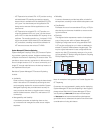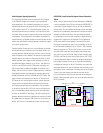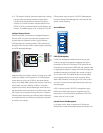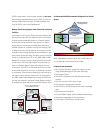47
devices. With z/OS and the zSeries, paths may be dynami-
cally assigned to control units to refl ect the I/O load. For
example, in an environment where an installation normally
requires four channels to several control units, but occa-
sionally needs as many as six, system programmers must
currently defi ne all six channels to each control unit that
may require them. With Dynamic Channel Path Manage-
ment (DCM), the system programmer need only defi ne the
four channels to the control units, and indicate that DCM
may add an additional two. As the control unit becomes
more heavily used, DCM may assign channels from a pool
of managed channels, identifi ed by the system program-
mer, to the control unit. If the work shifts to other control
units, DCM will unassign them from lesser utilized control
units and assign them to what are now the more heavily
used ones. DCM is for ESCON and FICON Bridge chan-
nels can help reduce the number of channels required to
effectively run a workload. DCM can also help reduce the
cost of the fi ber infrastructure required for connectivity
between multiple data centers. On a z890/z990 with Logi-
cal Channel SubSystems (LCSSs), the scope of DCM man-
agement is within a Logical Channel SubSystem. Although
an LPAR cluster can span LCSSs, when DCM is used it will
only consider systems in the same LPAR cluster and the
same LCSS.
Channel Subsystem Priority Queuing
The notion of I/O Priority Queuing is not new; it has been in
place in OS/390 for many years. With IRD, this capability
is extended into the I/O channel subsystem. Now, when
higher priority workloads are running in an LPAR cluster,
their I/Os will be given higher priority and will be sent to
the attached I/O devices (normally disk but also tape and
network devices) ahead of I/O for lower priority workloads.
LPAR priorities are managed by WLM in goal mode.
Channel Subsystem Priority Queuing provides two advan-
tages. First, customers who did not share I/O connectivity
via MIF (Multiple Image Facility) out of concern that a
lower priority I/O intensive workload might preempt the I/O
of higher priority workloads, can now share the channels
and reduce costs. Second, high priority workloads may
even benefi t with improved performance if there were I/O
contention with lower priority workloads. Initially, Channel
Subsystem Priority Queuing is implemented for Parallel
OEMI and ESCON, FICON Bridge and native FICON
channels.
On a z890/z990, the scope of Channel Subsystem I/O
Priority Queuing is a Logical Channel SubSystem.
Channel Subsystem Priority Queuing complements the
IBM Enterprise Storage Server capability to manage I/O
priority across CECs.
With IRD, the combination of z/OS and zSeries working in
synergy extends the world-class workload management
tradition of S/390 and OS/390 so that the most important
work on a server meets its goals, to increase the effi ciency
of existing hardware, and to reduce the amount of inter-
vention in a constantly changing environment.
Parallel Sysplex Professional Services
IBM provides extensive services to assist customers
with migrating their environments and applications to
benefi t from Parallel Sysplex clustering. A basic set of
IBM services is designed to help address planning and
early implementation requirements. These services can
help you reduce the time and costs of planning a Parallel
Sysplex environment and moving it into production. An
advanced optional package of services is also available
and includes data sharing application enablement, project
management and business consultation through advanced


















